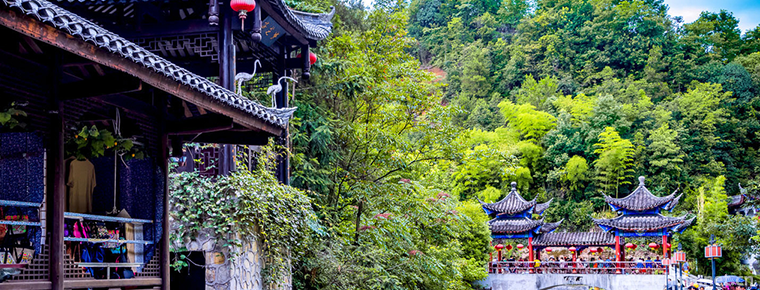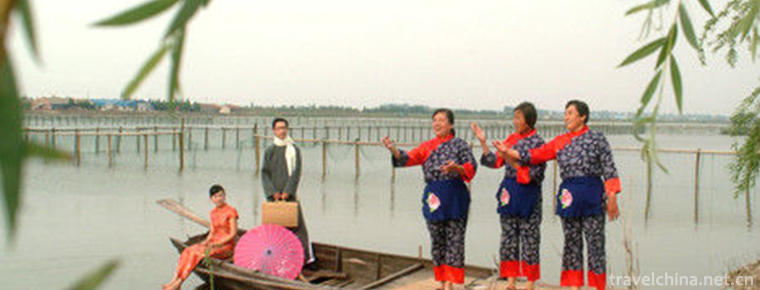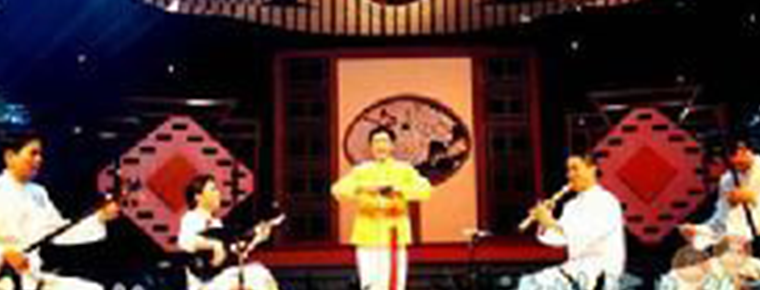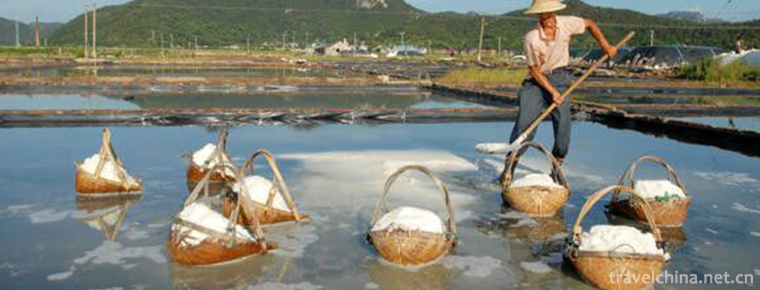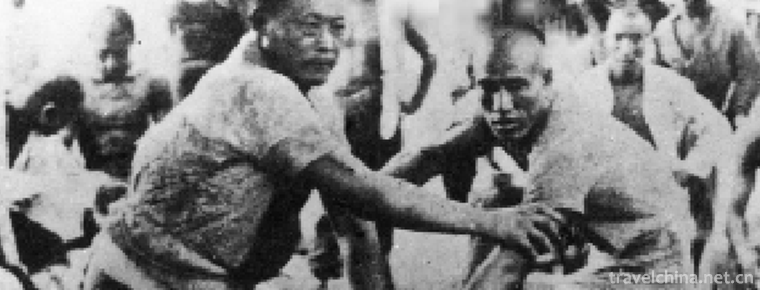Dayan Pagoda Datang Furong Garden Scenic Area
The Furong Garden of the Tang Dynasty is located in Qujiang Development Zone in the south of Xi'an City, Shaanxi Province, on the southeast side of the Big Wild Goose Pagoda. It was rebuilt in the north of the former Furong Garden site in the Tang Dynasty and imitated the style of the Royal Garden in the Tang Dynasty. It is the first large-scale Royal garden-style cultural theme park in China to display the style of the flourishing Tang Dynasty in an all-round way, covering
The park has Ziyun Tower, Ladies Hall, Royal Banquet Palace, Apricot Garden, Fanglin Garden, Fengming Nine-day Theatre, Tang City and many other antique buildings. It is the largest imperial building complex of imitating Tang Dynasty in China. The scenic spot is planned and designed by Zhang Jinqiu, academician of Chinese Academy of Engineering.
The Furong Garden of the Great Tang Dynasty started construction in 2002 and was completed in 2004. It was officially opened to the outside world on April 11, 2005 (the third day of March in the lunar calendar). On January 17, 2011, it was awarded National AAAAA Tourist Scenic Spot by the National Tourism Administration.
In the 2008 Northwest China Tourism Marketing Conference and Tourism Equipment Exhibition, it was included in the "Magic Northwest 100 Sceneries" list.
Xi'an Datang Furong Garden is located in Qujiang New District, Xi'an City, Shaanxi Province. It is on the southeast side of Dayan Pagoda and connected with Qujiang Chi Site Park in the south. The Furong Lake in the park is connected with the waters of Qujiang Chi. The Furong Garden of the Tang Dynasty was built at the site of the former Furong Garden site in the Tang Dynasty, covering an area of more than 1000 mu, of which the water area is 300 mu, with a total investment of 1.3 billion yuan. Furong Garden in the Tang Dynasty is a collection of fourteen scenic and cultural zones, including imperial culture zone, female culture zone, poetry culture zone, imperial examination culture zone, tea culture zone, singing and dancing culture zone, catering culture zone, folk culture zone, diplomatic culture zone, Buddhist culture zone, Taoist culture zone, children's entertainment zone, gate landscape culture zone and Shuixiu performance zone. The splendid spiritual outlook, splendid, unparalleled culture and art, as well as its magnificent atmosphere across the sky and looking at everything. The main scenic spots in the park are: Ziyun Tower, Fengming Nine-day Theatre, Royal Banquet Palace, Tang City, Fanglin Garden, Ladies'Hall, Caixia Pavilion, Lu Yu Tea Club, Apricot Garden, Poetry Soul, Tang Shixia, Qujiang Liuyin, Qiting, Liren Pedestrian, Taohuawu, Zhuyutai, etc. These scenic spots are mainly built around Furong Lake. Ziyun Tower is the center of the whole scenic area.
Main scenic spots
Imperial Cultural Area
The Imperial Culture Zone, represented by Ziyun Tower, the landmark building of the whole garden, demonstrates the style of Tang Dynasty emperor that "the form and spirit ascend into the purple clouds and the world submit to the emperor's heart". The Ziyun Tower in history was built in the 14th year of Kaiyuan in Tang Dynasty. Every Qujiang Congress, Emperor Ming of Tang Dynasty would come to this building to enjoy singing and dancing, and to give banquets to all the officials and the people. The Ziyun Tower, which is rebuilt according to historical data, is located in the center of the present Park and one of the most important imitation buildings of Tang Dynasty. The main building has four floors, each of which has different angles and carriers to display the culture of the Tang Dynasty. The first layer is composed of sculptures, murals, restoration models of the large-scale Tang Chang'an City and the first-class Tang Cultural Relics Exhibition. On the second floor, the Tang Ming Emperor gave banquets to his ministers. Eight parties came to the DPRK and Wanbang to worship large-scale painted sculptures. Ziyun Tower is an important scenic spot performance area in the park. The multi-functional Performance Hall on the third floor performs the "workshop music and dance" for you. Four floors are equipped with Ruyi Bronze Tower Throwing Game.
Shuixiu Performing Area
Shuixiu performance area is located on the lake in front of Guanlantai, Ziyun Tower. It is a world-class modern water landscape with water curtain film, music fountain, laser flame, mine and mist as one. The world's largest water curtain film, 120 meters wide and 20 meters high, with laser-assisted, highlights the flow texture of water on the water curtain, and uses laser performances to form a combination of music, fountains and lasers on the water. The sensory stimulating effects of fire, mine and water mist are designed in a variety of ways, which enables visitors to feel this collection of acoustics and Optoelectronics from the visual, auditory and tactile aspects. Water and fire as one of the unique water show performances. The water screen movie "Tang Chasing Dreams" takes visitors across time and space to meet with historical celebrities. After the water screen movie is over, there is a fire dragon and steel spark show.
Song and Dance Cultural Area
Located in the south of Ziyun Tower, Fengming Jiutian Theatre is a modern imperial theatre with a flourishing Tang style in the Song and Dance Cultural Area. The theatre is luxuriously decorated and reflects the Royal style. The main program of the theatre is Dream Back to Tang Dynasty. With modern artistic techniques and new audiovisual effects, the social spiritual features of Tang Dynasty in its flourishing age are displayed.
Catering Culture Area
"Tangfeng Restaurant delights guests and salivates at delicacies. Drink good wine with water and flowers, and be at ease." Royal Banquet Palace, located in the north of the west gate of the park, is the center of displaying the Tang Dynasty's catering culture. It is a large themed catering area that integrates gourmet food, artifacts, wine and music. It has a large-scale experiential catering banquet garden featuring Tang culture and Party culture, Royal banquet, medium and high-grade group banquet, business banquet and Party banquet. It also provides visitors with a buffet as the main form of dining places, to meet all aspects of the dining needs of tourists.
Folk Culture Zone
Common things in the city are the most lively places. Tang City, a folk cultural area, is located in the south of the park. It consists of Tang Fair and Theatre building square, covering an area of 12,022 square meters. The second phase of the project of Tang Dynasty is the Tang Dynasty Custom and Culture Street, which is a microcosm of the ancient Chang'an City for trade and commercial activities, with the commercial and cultural atmosphere reflecting the "gathering of businessmen and businessmen, integration of entertainment, entertainment, experience, exchange and consumption" as the core. After one year's construction, it will be opened to tourists on May 1, 2012, and will restore the citizens and tourists. A flourishing ancient market in Tang Dynasty. At the same time, the opening ceremony of the Second Xi'an Qujiang International Light and Film Festival will also be held here.
During the holidays from April 29 to May 1, 2012, Tangshi District will hold splendid performances, such as folk life, folk dance, wonderful acrobatics, Western bands, lion gongs and drums dance, living sculpture, thrilling martial arts, ancient costume show, and other performing teams, together with unique opening and closing ceremonies, which will create a Tang Dynasty cultural scenario experience street for tourists.
In addition to Festival performances, Tang also prepared daily performances for tourists and citizens, including Qin Opera, acrobatics, lion dance, music and many other projects. Every weekend, embroidery balls, neon feather dancing and Western style bands will bring different feelings to tourists.
Female Cultural Zone
Female cultural area, represented by the Ladies'Hall and Caixia Pavilion on the North Bank of Furong Pool, demonstrates the spiritual features of Tang Dynasty women's "ragged style, daring to compete with men for the world; 3,000 tender feelings, which runs through ancient and modern popular names". The Ladies'Hall is a group of imitating Tang Dynasty buildings centered on Wangchun Pavilion. It shows the positive, optimistic and self-confident spiritual features of women in Tang Dynasty from the aspects of dress, sports, political participation and love. The northern Hall of the Ladies'Hall, with the program performance of the Tang Ladies' Clothing Exhibition of "Bright Shadows and Neon Clothes", shows the splendid costumes, gorgeous colors and beautiful ancient music of the Tang Dynasty ladies'demeanor dynamically. The Caixia Pavilion, with a total length of nearly 300 meters, stretches from north to East in accordance with the water, sometimes bordering the lake, and sometimes standing in the water of the Ningli Lake, such as a touch of Caixia, is a long corridor for cultural stories that show the legends of women in the Tang Dynasty and reflect the various forms of life of women in the Tang Dynasty.
Tea-tasting Cultural Area
"Three pieces of Lu Yu Jing, seven degrees of Lu Tu tea, window-facing friends, delicate Zen tea, laughing at Qu Jiangbo, detached from each other." Located in the tea cultural area of the park, Luyu Tea Club, named after Lu Yu, the "Tea Saint" of the Tang Dynasty, highlights the theme of tea culture in the Tang Dynasty. It is a comprehensive and high-grade tea art club composed of imperial tea art, literati tea art, secular tea art and tea art performances. Tourists here can not only enjoy the fragrant tea, but also enjoy the tea performance.
Imperial Examination Cultural Area
The apricot garden, which is close to the north gate of the park, is a scenic spot in the imperial examination cultural area to display the culture of Jinshi and official career in the Tang Dynasty. The Apricot Garden in history was named for its abundant apricot forests. Every early spring, when apricot blossoms are in full bloom, people come here to enjoy flowers and visit. The Apricot Garden was also the place where the new intellectuals of the Tang Dynasty held the "apricot garden flower exploring banquet". The newly reconstructed Apricot Garden is a courtyard-style imitation of the Tang Dynasty building complex, which is a display and management site with the theme of reflecting the imperial examination culture of the Tang Dynasty. Shaolin Temple disciples are invited to perform martial arts performances to let tourists appreciate the unique charm of Chinese martial arts.
Poetry Culture Area
Tang poetry is the treasure of Chinese classical poetry and the Pearl of world cultural heritage. The poetry culture area, which is composed of the soul of poetry and Tang Shixia, not only displays the poetry culture of the Tang Dynasty in the form of sculpture, allowing visitors to appreciate the art of sculpture, but also appreciates the broad-minded demeanor of the poets of the Tang Dynasty and the inherent essence of the poetry of the Tang Dynasty. At the same time, it also uses many traditional artistic techniques such as Chinese landscape, Chinese sculpture, Chinese calligraphy, Chinese seal engraving, graphic patterns and so on. The large-scale landscape art sculpture area was created.
Diplomatic and Cultural Zone
The diplomatic and cultural zones show the frequent exchanges of envoys from different countries in the flourishing Tang Dynasty and the commercial and cultural atmosphere of "businessmen and businessmen gathering together, accommodating both inside and outside". Let visitors feel the prosperity of the world's exchanges with the Tang Empire in the flourishing Tang Dynasty. Located in the area - Qujiang Hudian, surrounded by water on three sides, is the port of call for ships and the best place for water tourists to enjoy leisure and recreation.
Children's Entertainment Zone
There are numerous prodigies in the Tang Dynasty, located in the children's playground on the north side of Ximen. With the "prodigy culture" as the core, through entertainment facilities full of fun and entertainment, various forms of landscape techniques, the prodigy stories and legends of the Tang Dynasty, as well as the rich and colorful children's playground activities of the Tang Dynasty are displayed. There are Huzizhai, waterwheel, self-pavilion, Yuanbai sleepwalking Qujiang River, prodigy road and so on.
Tourist guide
Fare information
Tickets for scenic spots: 120 yuan per person in peak season, 60 yuan per person for students; 90 yuan per person in off season (tickets for scenic spots, water curtain movies, and various performances, excluding "Dreamback to Tang" show)
Scenic area ticket package: 140 yuan per person (scenic area ticket, water curtain film, dream back Tang song and dance and other performances)
Special crowd booking criteria (special people do not need online booking, can go directly to the scenic spot to buy their own tickets):
A. Free policy: free tickets for children under 1.2 meters; free tickets for elderly people over 65 years old; free tickets for military officers and disabled persons with disability certificates.
B. Preferential policies: 45 yuan per person for children's tickets for height 1.2-1.4 meters
Opening Hours
9:00-21:00 (20:30 Qingyuan), "Dream Back to the Tang Dynasty" performances 17:15-18:25, water screen film performances 19:45-20:08.
Traffic information
Public transportation
Route 21, 22, 23, 24, 601, 610, 609, 237, 715 and 907
Bus routes 21, 22, 24, 41, 212, 224, 237, 320 (You 9), 601, 609, 610, 715, 720 are accessible. (You can take K5 from the railway station to the Big Wild Goose Pagoda and then take the above vehicles.)
Tip: Datang Furongyuan Station can be divided into Ximen Station and Nanmen Station (two of which are Ximen Station). The Furong Garden in the Tang Dynasty is now open to the North Gate (Chunming Gate), the West Gate (Yuyuan Gate) and the entrances and exits of Tang City, of which the West Gate is the main gate from which tourists generally enter.

















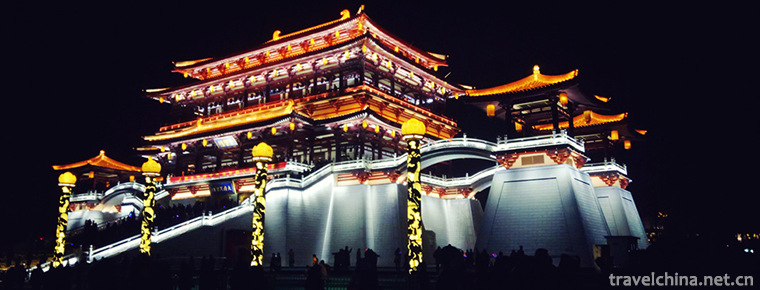
-
Jiulong Mountain Rural Tourism Scenic Area
Mianzhu Jiulongshan Rural Tourism Scenic Area is located in the northwest of Mianzhu City, Sichuan Province. It is a characteristic rural tourism area.
Views: 138 Time 2018-12-22 -
Zengjiashan Scenic Area
Zengjiashan Scenic Spot is located in Chaotian District of Guangyuan City, south foot of Qinba and the combination of Sichuan and Shaanxi. It covers 6 townships and townships with 70,000 people.
Views: 131 Time 2019-01-04 -
Tangya Tusi City Site
Tangya Tusi Town Site is located in Tangya Town, Xianfeng County, Enshi Tujia and Miao Autonomous Prefecture, Hubei Province, with its back to Xuanwu Mountain and facing Tangya River..
Views: 153 Time 2019-02-13 -
Jiashan Tian Ge
Jiashan Tiange is a local folk song in Zhejiang Province. It belongs to a variety of Wuge songs. It is a unique form of ballad in Zhejiang Province. It is a song that workers sought comfort and expres.
Views: 304 Time 2019-05-05 -
Brocade song
Brocade song, formerly known as Gezi or Shijin song, is also called begging tune. It was named Jinge in 1953. This is a form of singing accompanied by instrumental music. .
Views: 331 Time 2019-05-07 -
Ping Ju Opera
Opera commentary is a kind of opera which is spread in the north of China. It is one of the most popular operas among the people and ranks among the five major Chinese operas. Some people once thought.
Views: 141 Time 2019-06-09 -
Salt drying Techniques
Salt-drying process is a special kind of handicraft technology. Its existing form is different from the general intangible culture. Its products are closely related to people's daily life and industri.
Views: 135 Time 2019-06-13 -
Flyover wrestling
In the 1930s, when Peiping wrestling was very popular, Peiping wrestling was famous all over the country. At that time, the strongest wrestling master of Peiping overpass was Shen San (Shen Yousan), B.
Views: 372 Time 2019-06-21 -
Production Techniques of Wufangzhai Zongzi
The traditional production techniques of Wufangzhai zongzi are mainly divided into 36 processes, such as material selection, rice dipping, leaf boiling, stuffing, shelling, wrapping, thread binding an.
Views: 213 Time 2019-06-29 -
Zao Bang
Zaobao is one of the traditional local operas in Shandong Province. It is mainly popular in Heze, Yuncheng, Liangshan, Juye, Juye, Juancheng and Dingtao. It developed under the influence of local lang.
Views: 235 Time 2019-07-16 -
Qixian Lake
Qixian lake water resort is located in Fuxing Town, Gaoxian County, more than 40 kilometers away from Yibin City. It is the largest mountain water storage Lake in Yibin City, with a water area of 2632 Mu and a total area of more than 50 square kilometers. It was listed as a regional scenic spot in 1988 and approved as the first batch of provincial wetland park by Sichuan Provincial People's Government in 2008..
Views: 370 Time 2020-10-16 -
Chuanxindian earthquake site
Compared with Beichuan earthquake site, Yingxiu earthquake site and Hanwang town earthquake site, chuanxindian earthquake site in Shifang has unique advantages. It can fully reflect the great spirit of earthquake relief and has great protection and construction value..
Views: 101 Time 2020-11-05


